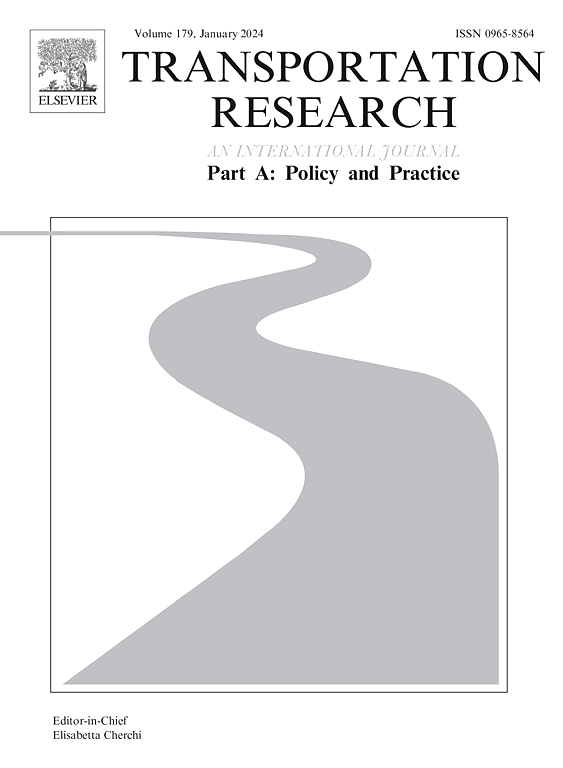The impacts of exchange rate fluctuations on the international air transport
IF 6.3
1区 工程技术
Q1 ECONOMICS
Transportation Research Part A-Policy and Practice
Pub Date : 2025-05-27
DOI:10.1016/j.tra.2025.104523
引用次数: 0
Abstract
The fluctuations of foreign exchange rate can affect the international air transport markets through both demand and supply sides. On one hand, exchange rate variations can affect the passengers’ overseas purchasing power so as to influence international travel decisions (i.e., demand side). On the other hand, as airlines normally pay foreign currency (e.g., the U.S. dollar) for capital/operation costs, the foreign exchanges rate variations also affect airlines’ supply side. This empirical study utilizes monthly data on international routes operated by Chinese airlines (January 2017 – September 2019) to analyze demand and supply dynamics of foreign exchange variations through structural econometric modeling. The impacts on the air passenger traffic from both demand and supply side can be thus disentangled and quantified. To address the potential endogeneity caused by the unobservable confounding factors that jointly affect the exchange rates and international air travel market, this paper innovatively selects the international air routes linking mainland China to five regions that peg their exchange rates to USD, such that the exchange rate fluctuations can be regarded as exogenous on these routes. The empirical findings indicate that on the demand side the moderate bidirectional exchange rate fluctuations significantly influence international passengers’ air travel demand, while on the supply side severe fluctuations significantly impact airfare. Additionally, the demand in China’s aviation market is generally inelastic to airfare and exchange rate fluctuations. By separating the demand-side effects into direct and indirect mechanisms, the findings show that moderate exchange rate fluctuations primarily impact air travel demand through a direct mechanism, (i.e., the demand side) while severe fluctuations mainly influence demand through an indirect mechanism (i.e., the supply side). The findings offer useful references for airline managerial and policy implications.
汇率波动对国际航空运输的影响
外汇汇率波动对国际航空运输市场的影响可以通过供需两方面来体现。一方面,汇率变化会影响旅客的海外购买力,从而影响国际旅行决策(即需求侧)。另一方面,由于航空公司通常以外币(如美元)支付资本/运营成本,外汇汇率的变化也会影响航空公司的供给侧。本实证研究利用中国航空公司运营的国际航线月度数据(2017年1月- 2019年9月),通过结构计量模型分析外汇变动的供需动态。因此,需求方和供给方对航空客运量的影响可以得到解耦和量化。为了解决共同影响汇率和国际航空旅行市场的不可观察的混杂因素所带来的潜在内生性问题,本文创新性地选择了中国大陆与五个汇率与美元挂钩的地区的国际航线,使这些航线的汇率波动可以视为外生的。实证结果表明,在需求侧,适度的双向汇率波动显著影响国际旅客的航空旅行需求,而在供给侧,剧烈的汇率波动显著影响机票价格。此外,中国航空市场的需求通常对机票价格和汇率波动缺乏弹性。通过将需求侧影响分为直接机制和间接机制,研究结果表明,适度的汇率波动主要通过直接机制(即需求侧)影响航空旅行需求,而剧烈波动主要通过间接机制(即供给侧)影响需求。研究结果为航空公司的管理和政策提供了有益的参考。
本文章由计算机程序翻译,如有差异,请以英文原文为准。
求助全文
约1分钟内获得全文
求助全文
来源期刊
CiteScore
13.20
自引率
7.80%
发文量
257
审稿时长
9.8 months
期刊介绍:
Transportation Research: Part A contains papers of general interest in all passenger and freight transportation modes: policy analysis, formulation and evaluation; planning; interaction with the political, socioeconomic and physical environment; design, management and evaluation of transportation systems. Topics are approached from any discipline or perspective: economics, engineering, sociology, psychology, etc. Case studies, survey and expository papers are included, as are articles which contribute to unification of the field, or to an understanding of the comparative aspects of different systems. Papers which assess the scope for technological innovation within a social or political framework are also published. The journal is international, and places equal emphasis on the problems of industrialized and non-industrialized regions.
Part A''s aims and scope are complementary to Transportation Research Part B: Methodological, Part C: Emerging Technologies and Part D: Transport and Environment. Part E: Logistics and Transportation Review. Part F: Traffic Psychology and Behaviour. The complete set forms the most cohesive and comprehensive reference of current research in transportation science.

 求助内容:
求助内容: 应助结果提醒方式:
应助结果提醒方式:


